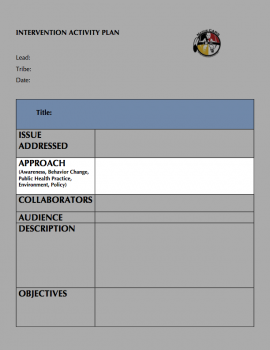The next step is to determine what is the best APPROACH to address the issue you identified in your tribal community. At this juncture you need to think back to what you may have learned so far such as what you heard from your coalition, acquired from your community readiness.
The different intervention approaches are:
AWARENESS interventions strive to inform the public about particular public health issues, concerns, and solutions. This approach works well for people who do not know that children under 4’9” should ride in a booster seat, for example. Or, perhaps the community is not aware of a new child passenger safety law. Your job will be to tell them.
Examples of awareness interventions may include the following:
- Media campaigns (newspaper, billboards, public service announcements)
- Written publications (brochures, leaflets, documents)
- Printed messages (posters, displays)
- Informal Messaging (social media)
See Module 7 for help with media interventions.
HEALTH EDUCATION interventions give people information on safe choices. You might teach them more about correct installation of a child safety seat, or share some of your community’s data on barriers to car seat use. You could share strategies for improving child safety seat use and connect people with community resources, like your distribution program or a child passenger safety seat technician.
Examples of health education interventions include:
- Classroom instruction
- Educational handouts
- Hands-on demonstration
See Module 8 for help with education interventions.
BEHAVIOR CHANGE interventions strive to create a physical environment that supports, promotes, and encourages the healthy behaviors that address the issues.
Examples of behavior change interventions include the following:
- Creating supportive social networks
- Making local resources that support healthy behaviors available
- Establishing healthy norms
- Developing talking circles and support groups
HEALTH AND SAFETY PRACTICE approaches foster health or safety promotion by supporting existing tribal or community health programs, through providing support to enhance existing programs at the community level or change the health or safety practices with in that program.
Examples health and safety practice include the following:
- Working with hospital delivery nurses to assure that children leave the hospital in car seats
- Working with Head Start programs to train and maintain certified child passenger safety technician to help parent correctly install seats.
ENVIRONMENT AND POLICY INTERVENTIONS strive to establish and enforce practices, policies, or laws that promote healthy behaviors and discourage unhealthy choices. This type of intervention usually takes the longest amount of time to achieve, but has the greatest potential for lasting impact.
Examples of environment and policy interventions include:
- Enacting tribal policies and resolutions
- Mandating specific programs
- Creating drop off areas at tribal daycare where car seat use can be viewed
See Module 11 for help with policy and law interventions.
To learn more about identifying your collaborators, go to the next section.

